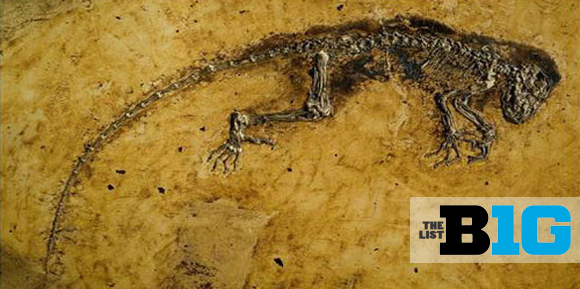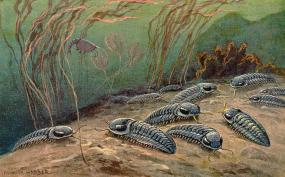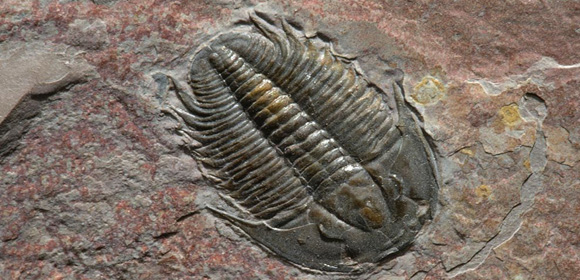
Fossils.
I love 'em! Little ancient monster bones buried in the dirt, they're like terrifying Easter eggs put in the ground for weird kids and weirder adults to dig up and show off to other weird kids and weird adults.
And if you were a weird kid (I was), you likely spent a fairly large percentage of your waking hours looking for fossils, hoping that by some insane stroke of luck you'd find a T-Rex femur or Deinonychus claw stuck in the sheet rock that your neighbors used to edge their lawns. After all, that's more or less how dinosaur fossils were found in the late 1800s, and if it was good enough for Othniel Marsh then it was good enough for Johnny Ginter.
One advantage that I had was that I grew up near Caesar Creek, where I did a lot of fishing and staring at rocks in order to find the remains of whatever goofy thing the Cambrian era decided to spit out into the universe. I was fascinated by the sheer amount of fossils around and how incredibly crappy most of them were; sometimes you would find a petrified shell thing, which was awesome, but most of the time it was just bits and pieces of an evolutionary dead end that we'd now serve as an appetizer at Red Lobster.
State fossils gave me hope. Because dagnabit, if there's enough of a certain type of fossil within a state to make it the official state fossil, it stands to reason that there must be literally trillions of the things buried in the ground, and all I needed to do was dig around with a trowel in my backyard long enough and I'd find one, probably way more though because I labored under the impression that I was smart.
I wasn't, and I'm not, and I never found anything cool outside of Caesar Creek or apologized to my mom for tearing up her yard. But official state fossils are still pretty rad.
First thing's first. Minnesota, Iowa, and Indiana do not have state fossils. This is stupid, considering the incredibly rich and varied geological history of the Midwest, and even stupider for Minnesota because of the ice age megafauna, among the most common in the Great Lakes region was the giant beaver. Which you might think is a somehow misleading name, but nope, it was just a bigass beaver.
This is like the easiest call in the world, guys. Get on it.
8. Illinois: Tully Monster (Tullimonstrum gregarium)
Ugh, terrible. Despite the what it sounds like, tully monster is not the nickname of a guy who lives above the garage in a 90s family comedy on TGIF. Instead, it's a gross sea cucumber thing that looked like it was created by someone pulling a lever on a slot machine in Vegas and agreeing to live with the result. The reason why it's the state fossil of Illinois is because so far it's only been found in the state, but that's more of a knock on Illinois than anything else.
7. Maryland: Ecphora (Ecphora gardnerae)
 Gazelles of the sea
Gazelles of the seaRule of thumb when selecting state fossils: make sure it's something that doesn't currently exist. Ecphora was just a big snail in a conch shell. Who the hell cares? No kid has ever looked at a fossilized Ecphora and gone "I love science and the infinite possibilities that implies." They may, in fact, have gone "oh yeah grandma has one of those in her living room on a doily. It's covered in lacquer and smells like something died in it."
And then when it's willed to them they keep it on the same doily for a couple of months, before eventually throwing it out because it's started to attract ants. What I'm saying here is that Maryland's state fossil is ennui.
6. Wisconsin: Trilobite (Calymene celebra)
Trilobites will be showing up more than a few times on this list; and let's be honest, who doesn't love giant underwater bugs? Unfortunately, Wisconsin picked a weird week to confront its crippling social anxiety issues, and the result is the tiniest freaking trilobite that you've ever seen. It's almost like a parody of a real trilobite, and at 4 millimeters long, it's more than a little amazing that anyone noticed it enough to make a Wikipedia page about it. Said Wikipedia page is all of 20 words long, but it's the thought that counts.
5. Michigan: American Mastadon (Mammut americanum)
Okay, so great. You've selected a big ancient elephant as your state fossil. Congratulations, except for the fact that it isn't really that big, isn't adorably hairy like Snuffleupagus, and were the mastodon alive today it'd be prime target for our sharpened spears, slingshots, and heavy netting. I have thoroughly examined the weaknesses of your precious mastodon, and discovered that it's biggest problem is that it has a difficult time blending in at all the cool wooly mammoth nightclubs. That alopecia excuse only works for the first few times, and then word gets out. Trust me, I know.
4. Pennsylvania: Trilobite (Phacops rana)
A slightly more impressive trilobite than calymene celebra, I still am having a hard time believing anything on its Wikipedia page:
In order to protect themselves from predators, Phacops rana would roll into a ball with its hard exoskeleton on the outside as protection. Many other trilobites possessed the same ability, but Phacops rana nearly perfected it. The slightest amount of sediment would trigger their senses, and Phacops rana would be hidden in a tiny shelter made of its own body.
"Nearly perfected it??" First of all, frog eyes, you had millions of years to fully perfect this lame defense, don't half-ass anything in life. If an armadillo can do it, so can you. Secondly, this segment reads like a mash note from fourth grade. We get it, phacops rana was great, who cares? Let's move on, geez.
3. Nebraska: WOOLY MAMMOTH (Mammuthus primigenius)
All the best animals, living and extinct, are really just versions of other animals with a bonus feature that makes them awesome. Whales are cool, but how about adding on a kickass horn? Boom, narwhal. You know, I think squirrels are cute, but they're kinda boring. What if they could fly? Bam, sugar glider. I like anteaters, but I also like things that look like armored personnel carriers. What's a guy to do? Kapow, pangolin.
Enter the wooly mammoth. It's a mammoth, but covered in luxurious hair, like some kind of insane Locks of Love fever dream. I don't know of a single kid in the whole world who didn't look at a picture of the wooly mammoth for the first time and go "I wish I was a Viking and could pillage Europe on the back on one of those things."
2. New Jersey: Hadrosaurus (Hadrosaurus foulkii)
Finally! Look, when you're looking for or discussing fossils, there is a clear hierarchy. It goes weird worm things - plant impressions in rock - sea bugs - tiny little ancient mammals - ice age megafauna - DINOSAURS.
And it makes no sense that more dinosaurs aren't state fossils. I don't care if they haven't been found in the state or not, every state deserves an official state dinosaur fossil. New Jersey lucked out, in the sense that in the 1830s some dude found hadrosaur bones while digging around in a pit (see, I told you it works), and 150 years later they finally wised up and made it their official state fossil. The hadrosaur is a pretty mediocre herbivorous dinosaur in the grand scheme of things, but hey, bragging rights for all of New Jersey's 8 year olds for eternity is not a bad deal.
1. Ohio: Trilobite (Isotelus maximus)

I'm sure there's some snide Michigan fan out there going "Yeah right, Johnny. There's no way that this trilobite is in any meaningful way different from the other two trilobites that you already listed and trashed on this list. Why, it's almost as if this list is completely arbitrary and not a genuine analysis of the relative merits of state fossils!"
First of all, shut up. You have no idea the kind of effort and work it takes to compile a list of random things, put numbers next to them, and then add pithy jokes. If anyone could do it, this kind of thing would be all over the internet. But it's only here, on Eleven Warriors dot com, where you can find mundane things sequenced in descending order with jokes. DO NOT ATTEMPT TO FIND OTHER LISTS.
Secondly, shut up! "Isoltelus maximus" means "super cool and big" in Latin, and that's what this trilobite is. If I'm going to have a seafaring rolly polly as my state fossil, it's going to be a BIG seafaring rolly polly. Plus, if you think about it, hundreds of millions of years ago Ohio had some pretty choice seafood right on it's shores, so if it happened once it can happen again. Now we just play the waiting game.
There. That is over 1500 words about state fossils, and I hope you enjoyed every one of them. Next time we'll take a long, hard look at state flags, and why there are three simple rules for determining if your state flag sucks or not. See you then.
The B1G List: State Birds | State Mottos | State Flowers | State Songs | State Fossils

